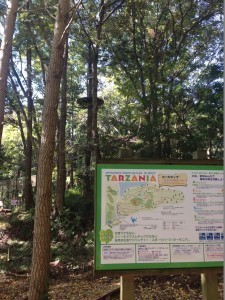Regina Glei's Blog, page 29
December 19, 2014
How to transit airports in Shanghai
It’s travel time again and I’m on a rather challenging tour right now.
From Tokyo to Singapore via Shanghai. After a week in Singapore on to Germany and back to Japan another week later via Vietnam.
The journey started at Haneda airport, which I rarely use. Somehow I am mostly ending up at Narita. This time though the route was Haneda – Hongqiao, which is only an hour from Tama-Plaza station, my “airport hub”, and not two like Narita.
The weather was glorious, typical Tokyo winter weather, cold but clear blue skies and blinding sunshine. From Yokohama Bay Bridge Mt.Fuji presented itself in winter glory with the Yokohama landmark tower in the foreground. Always a great sight!
The short flight to Shanghai was packed, but with only three hours of flight time it wasn’t too bad.
Arrived at Hongqiao airport a little adventure ensued for the cheap ticket traveler. My flight to Singapore would leave from Pudong airport, not Hongqiao…
First of all, I had no visa for China. I had checked in the Internet and it said, if you are transiting, you don’t need a visa but can apply for a 72 hour one directly at the airport. So I boldly stepped to the immigration desk telling them I had no visa. The immigration officer lady checked a bunch of things, wanted to see my eticket and called someone else whom I had to follow to a separate desk where documents were filled out and I ended up getting a 24 hour visa, not a 72 hour one. Well, fine by me, as long as they let me in!
I collected my suitcase and stepped onto Chinese soil. Now, how to get to Pudong?
I had arrived at Terminal 1 of Hongqiao and already knew that I needed to go to terminal 2, I had once phoned China eastern airlines in Tokyo who had told me so. But there was no sign, nothing, and I asked a guard guy – he spoke no English, however, some very friendly lady stepped in and gave me instructions. Go up to departure level, take the free shuttle to terminal 2, there, ask for the bus to Pudong. I found the shuttle to terminal 2 which takes a full twenty minutes. Terminal 1 is very old, terminal 2 much newer. Arrived there I asked for the bus to Pudong at a sort of information desk and the lady there said, oh, but it takes 90 min with the bus, taxi only one hour, taxi is 500 RMB. Ha! I was glad for previous China experience. That is a ridiculous price. I asked how much the bus is, well, 30….. I demanded to be told where the bus was – she reduced the taxi price to 350. I told her, I’ve been to China before, I know it costs around 150 by taxi from near Hongqiao to Pudong. That shut her up and she told me where the bus was and was so kind to exchange 20 euros into 110 RMB so that I could pay the bus. I bet she gave me a ridiculous rate, but for twenty euro I shall be quiet. So she probably made at least a tiny bit of profit of me.
I had to meander around a bit until I found the bus and one full bus left in front of my nose. But the next one came only 15 min later. And guess what. The ride to Pudong with the bus took under one hour! Just don’t let them mess with you 
The traffic was insane. Tokyo is big, but Shanghai is a behemoth by now with fully packed 8 lane highways where you drive truly at your own risk…. So better in a big bus than in a rickety VW Santana taxi.
Weather in Shanghai wasn’t that bad actually, I had expected more smog. Seems I caught a low smog day. Arrived in Pudong, things went smoothly and I had three hours to kill before the flight to Singapore, which went smoothly as well and with the luxury of having two seats to myself. Upon arrival in Singapore it was raining badly, but more about Singapore later 
December 13, 2014
Kuala Lumpur Travel Report Part 2
I had to check out of my lovely hotel room already on Sunday morning, left my luggage where it was and headed again for Pasar Seni, the central market. From its platform you can see the construct of the national mosque and that was where I wanted to go, but easier said than done. After a labyrinth of elevated walkways over a stinking and neglected river, I ended at another half-abandoned looking station and saw yet another motorway blocking the access to the mosque.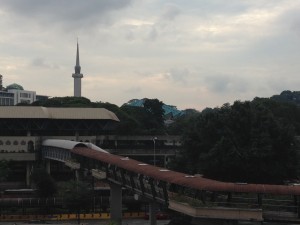
There was a lost looking young girl around and I addressed her and she also wanted to go to the mosque and so we tried together. She was from Spain (I’m afraid I forgot her name) and had just started with a one-year-around the world trip (ah nice!). Malaysia was her second place to visit, the first had been Japan.
We descended from the elevated walkway to the weird platform of this abandoned looking station, searching for a way out. Further south, the station turned out to be half in use, called Kuala Lumpur and it looked to me like it was the former main station, which was now replaced with the more modern KL Sentral Station one stop further south. The defunct building was neglected and spooky and I was glad for having company. We managed to get out, doubled back towards the mosque and ended up having to cross the motorway on foot, which we apparently both survived. I wonder how the regular visitors of the mosque get there… arrived at the mosque we found it again closed to non-believer visitors………. Again our two (different) guide maps said the mosque would be open for visitors until 13:00 but it was only open until 12:00… so far for two in-vain attempts to get into Malaysian mosques.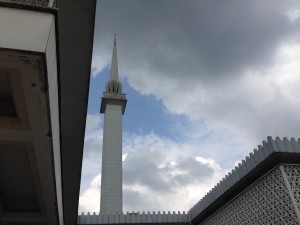
The Spanish girl and I sat down on a bench in the mosque’s park and debated what to do next. She wanted to have lunch, I just had a giant breakfast at the hotel and wasn’t hungry. She asked whether I had been to the Batu caves and I said no and she highly recommended me to go there. I had seen them in the guidebook but thought it was too much hustle to get there. By nice coincidence, the train there left right from the Kuala Lumpur station where we were at and so I decided spontaneously to follow her advice and we ventured back over the motorway to the station. She wanted to go to Pasar Seni to grab lunch and I was lucky that just a train to the Batu caves arrived, hoped on and waved good-bye to the Spanish girl. Thanks for the tip with the caves and good travels for the year to come!
The train was a highly welcome source of cool. It took only 25 min to get out of Kuala Lumpur and to the caves in the north. Kuala Lumpur is pretty flat and out of nowhere lime stone cliffs arise that are hollowed out by numerous caves.
There are three caves in total, let me call them the “ornament” cave, the “temple” cave and the “natural” cave.
The closest to the station was the ornament cave and accompanied by garbage checking monkeys, I paid 2 ringitt to get into the cave. Inside waited quite a surprise. Apart from being a stalactite cave there were hundreds of 3D papier mache figures describing scenes from an Indian religious canon centering around a god (I suppose) who has the body of a man but the face of a monkey. The cave was heftily lit and had two waterfalls on offer plus quite impressive stalactites and stalacmites.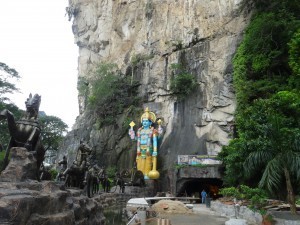
The most notable one was an alien-egg like cone that seems to have religious significance and was roped off. Two Indians asked me to take pictures of them in front of it. As for the ornaments, the most impressive one was a eleven-or-so faced king? whom the monkey god pointed at. Neither of them looked friendly in that scene. The entire ornament cave was bizarre and also tacky to Western eyes, but chubby-cheeked and bodied naked angels with white wings in Bavarian romantic churches surely look equally bizarre and tacky to Asian eyes.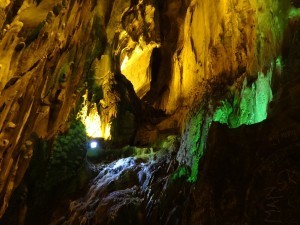
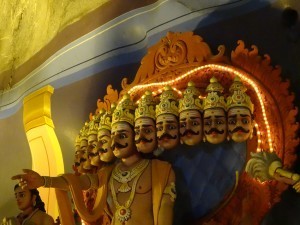
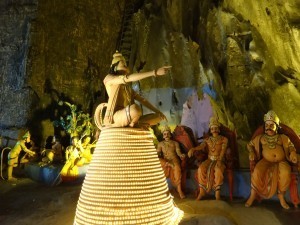
On I ventured past the temple on the ground and arrived at a giant golden statue of another god (a godess in this case) when it started to rain and thunderstorm mightily. More caves promised to be at the end of some hundreds of stairs but I waited a bit under a roof for the worst rain to stop. While it was still drizzling, I went up the stairs and passed by a side track with a sign saying “dark caves”. Oh, let’s explore those on the way back.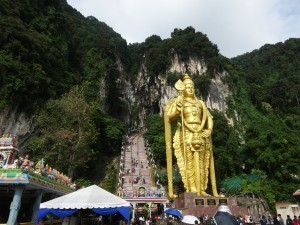
The temple cave on top of the mountain was impressive. Its main chamber was huge, over 70 meters high as the guide books said and what an interesting mix of religion, commerce, and nature the cave had to offer. Inside was a souvenir booth, a heap of industrial dirt, pipes, old machines, sacks with rubbish, and at the end of it more stairs to somewhere where natural light trickled in from above. I walked there and climbed the stairs to a fantastic round, sink-hole like opening in the mountain, with a small temple at the ground and trees protruding in wild angles from the rocks. The sink-hole with its temple inside was utterly beautiful and worthy of a movie location. The bizarre landscape was made even weirder by a cock carking half the time which ran around human feet inside the temple and apparently belonged there.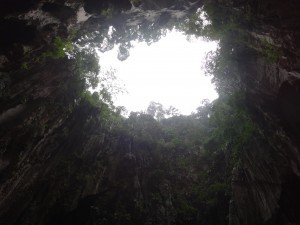
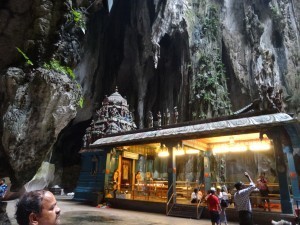
After making a hundred photos of the sink-hole, I finally pried myself loose and went back to the “dark cave” sidetrack. At the entrance to darkness stood a small booth where you could buy tickets for a dark cave tour and the next one would start 20 min later (and last about 45 min), waiting, I had a welcome rest at the cave’s entrance.
Equipped with helmets and flashlights some 15 tourists followed a guide girl, who led us into the publicly accessible part of the cave. The cave system is quite extensive and the girl said there were more than 200,000 bats living in it. You could hear them chattering above you and I saw one or the other batman flying by too. The girl looked like a student of biology to me, she was very knowledgeable about the wildlife in the cave and introduced us to several of its critters, including ten centimeter long centipedes with very long antennae… yuk! She said that in the 70ties this had been a tourist spot already and the caves had been lit up (like the ornament cave), a concrete path had been built through it and people had come unguided and had pick-nicks in the cave. Then, in the 80ties some environmental awareness kicked in and the tourists had been banned, the lights killed and guided tours had been established. Now you are not allowed to eat and drink in the cave, not allowed to leave the concrete path and don’t shine your light up at the bats! The guide lady revealed some beautiful rock formations with her bigger torch and led us until the grand hall, which has an access to the outside much like the sink-hole of the temple cave. I really liked our lady guide, you could feel and hear that she cared for the cave and the creatures inside it and I’m happy I made the tour.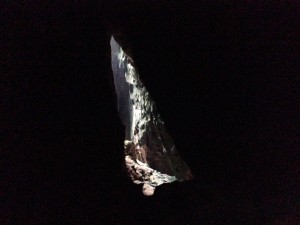
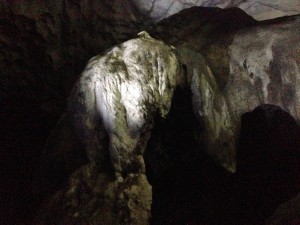
That were enough caves for one day for me though and time was also pressing, so I left the cave mountain walking down the giant stairs with monkeys jumping around me.
I’m very glad for having met that Spanish girl and having ventured to the Batu caves, which are very much worth a visit.
I rode by train back to the awkward Kuala Lumpur station and by subway back to the Petronas Towers, had some snacks in the garden behind them and then picked up my luggage from the hotel to ride by taxi to Kuala Lumpur airport.
Having seen so much of Kuala Lumpur and surroundings left no time for sightseeing in Penang, of which I basically only saw the airport, the hotel and our plant/office. I hope to get the opportunity to go again to Penang some time and see a bit more of that town.
One more general thing remains to be said – I had the impression that everyone in Malaysia speaks English. Might be the old influence of the once-British colony but I found it to be very practical and making things very easy if even the taxi driver understands you, in contrast to e.g. China (or Japan for that matter). Malaysia left a very good impression on me and I hope to be able to go there again one day.
December 6, 2014
Kuala Lumpur Travel Report Part 1
I’ve been on the road again – to Malaysia for the first time.
The schedule was a bit challenging: Work required me to be in Penang on Monday morning. So I arranged things that I could spend the weekend in Kuala Lumpur and fly in to Penang on the evening of Sunday the 30th. I arrived in KL at 4:15 in the morning and took a cab to the city. KL’s airport is a bit like Narita, many miles away and there was nothing to see yet in the dark. I had booked a hotel with Petronas Towers view and the taxi rode past them, but at 5 in the morning they are not lit up and looked not very impressive yet.
I asked the hotel for an early check in but could only get one together with a room upgrade… well, you live only once! So, I checked into my luxury room with Towers view and fell into bed for some 2.5 hours. Up at 9, the sun was shining and the Petronas towers presented themselves in full beauty. All that steel makes them shine like silver depending on how the sunlight falls on them.
I ventured out into the brooding tropical heat after breakfast and arrived at the towers at 11:00 in the morning. I thought to get up right away and queued for the tickets, only to have the guy at the counter telling me, oh, the first slot I can give you is at 13:00. Oops. I had no desire to hang out there for two hours and asked for a later slot, 5 p.m.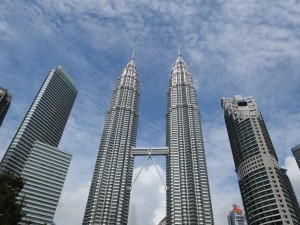
Boarding the subway system of KL for the first time (the subway is token based like the one in Istanbul, easy to use and wonderfully cooled), I headed for the Jamek mosque, one of the oldest mosques in KL. In the city map’s mini-guide book that I had received at the hotel it said it would be open for visitors until 13:00.
I arrived at the mosque at around 12:15 and it was closed for prayer preparations… hu… non-believers could only wander around its outside, women clad in screaming red full body “rental” capes and men in shorts had to put on long pants. Since I couldn’t get inside, that visit was quick and wandered instead through an adjacent, small and tacky bazaar. They had nothing but tinker and I went back to the subway station, riding on one station to Pasar Seni, the central market. That market has an outside area and a cooled down building next to it. If very tourist oriented and having loads of souvenir junk to offer, it has a nice, colorful atmosphere. I ate an adventurous chicken-based noodle soup in its air conditioned food-court and then went on to find my first Indian temple ever.
So far I have not yet been to India (it’s ranking high on my bucket list and I hope to be able to get there soon) so this was my first Hindu experience. The Sri Mahamariamman Tempel (Indian names are tough) looked very original and beautiful to me, and I’ll be thrilled to compare it with temples in the home country one day. Right next door was a great Chinese temple as well. To access the Hindu temple, the only thing you had to get rid of were your shoes, and you can just walk as you are into the Chinese temple.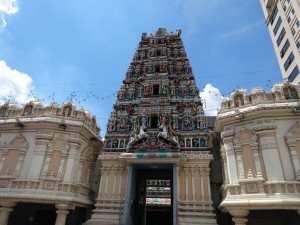
Behind a shopping street through Chinatown, I tried to get to a large park that looked close and easy to reach on my map. On the way were another two Chinese temples, one under heavy restoration, the other in use. My way ended next to the second temple at a large highway that was impossible to cross and on its other side were trees, yes, but also a construction site. Hm… I gave up on the park due to these obstacles and another one – heat! Over Chinatown also fat thunder storm clouds were brewing and it started to rain when I arrived back at the subway station.
Needing a break from the heat and rode to the Petronas Towers to cool down in its refrigerator, Christmas-decorated shopping mall, then discovered a beautiful and wide park right behind the towers. In the rear part of the park is a free paddling pool, if you can call it that. The water didn’t look deeper than 50 cm. Mostly children used the pool with their parents supervising them. Notably, the girls go into the water fully clothed.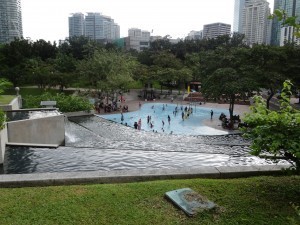
Malaysia’s population consists of 50% Malay, who are mostly Muslims, then some 20% Chinese and the rest is made up of various other ethnic minorities with the biggest two of them being of Indian and indigenous origin. The Malay women usually wear head-scarfs but do not hide their faces. Funny that even in a country with close to zero Christians there is X-mas decoration all over the place – well, it’s pretty and serves commercial purposes.
It was raining, stopping, raining, KL is currently in the rainy season. I was grateful for that though, since the rain takes a bit of the heat away.
Finally it was time to get up the towers and after rather hefty security measures (you have to go through a full fledged security scan, then, despite that, deposit your bag, and there is always a guard around wherever you go), a small group of twenty people, forced to wear red badges, was allowed up an elevator to the Skybridge first, that connects the two towers at floors 41 and 42. My group was the first that had the 5 pm slot and we were alone on the Skybridge for ten minutes. After ten minutes you have to wait at the elevator again (roped off, guard in front of you) while the second 5 pm group with green badges is allowed on the bridge. When the third group with blue badges arrives, the first group with the red badges is allowed further up.
The elevator brought us to floor 83, where we had to change elevators into two smaller ones, since the towers thin out at the top and these brought us up another 3 floors to the highest, 86. There is an 87th floor, but it’s off-limits. Since I was in the first group with the red badges, we had the 86th floor to ourselves for ten minutes, until the second group came up, which was great, since it gave us some time and space to explore the view without too many people in the way. So, if you ever go up the Petronas Towers, queue so that you get into the first twenty of your slot.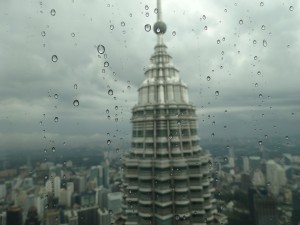
I really like the towers’ design with the alternating round, angular, round shape, all that silver looking steel and the cone shape with the spires on top. To me the towers look highly esthetically pleasing and I’ve become quite a fan of their architecture.
The view from atop the towers is of course very nice too, if it was obstructed by clouds. I spent more than an hour on the towers in total (they let groups green and blue mingle with the red one and that means red could stay longest).
It started to constantly rain from around 16:30 by the way and when I finally got down from the towers it was almost time for dinner. The shopping mall at the foot of the towers was bursting with people and frozen down to a ridiculous degree. I ended up eating Italian pizza in a roofed, outside restaurant at the foot of the towers, where it was not too warm or too cold thanks to the rainy weather.
After a brief stint back in the hotel to drop off my luggage, I ventured to the towers again to get night shots of them. The large pond behind the towers, which marks the beginning of the park, is having rainbow-lit fountain displays to music, which was quite nice (if reminding me a bit of Las Vegas).
The park was deserted in the nightly rain apart from a few picture hunting tourists like me and I got some excellent shots of lit up Petronas towers with clouds around them. The amount of energy going into lighting them up like that must be ridiculous, but it does look great.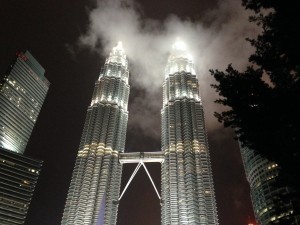
With the nightly Petronas Towers pictures in my camera, I went back to the hotel and fell into bed.
Stay tuned for my visit to the incredible Batu caves the next day in next weekend’s blog. Pictures of them are already on Flickr, if you want a sneak preview.
November 21, 2014
Introvert vs. Extrovert
We all need time for ourselves. Some need more time than others. There are many definitions of the two terms introversion and extroversion and wikipedia (as always) delivers a nice summary and explanation of the two terms.
I did the Myers-Briggs Type Indicator test last year or so and am an ENFP. Here is a definition.
I very much like one sentence from this wikipedia article which is “The least extroverted of the extrovert types, ENFP need significant time alone to center themselves…”
Yes! Yes! Yes! This is what I noticed (yet again) during the past week. I’ve been going through another 3-day company-initiated seminar on leadership (goal setting, employee evaluation and employee development) and while other seminar participants are going out drinking after a seminar day, I only want one thing – be alone! Going out drinking with the others is NOT relaxation for me but stress. After being together with 20 people doing interactive learning the whole day, the only thing I want is to NOT interact but shut the door behind me and not see anybody for a few hours. I desperately need this alone time to calm down, relax and “center myself”. What do I do during that alone time? Flee into my preferred world – whatever book I am currently writing or revising. So I lock myself in my hotel room and write a thousand or two thousand words, then watch some TV and play some iPad games, take a shower and go to bed. Having to constantly interact with people drains me like a vampire sucking at my throat.
So, despite being in principle outgoing (one of the teachers, who happened to ride with me on the same bus to the station after the seminar, called me a mood-maker) I need some time alone to stay sane. I knew this before, but this autumn, which is quite a high-stress autumn, has strongly confirmed this or made me aware of it.
Down time is of great importance and I shall fight for it. The high-stress period will continue for another two months or so (there is an end to all the seminars in sight end of January, yeah!). Next Friday, for example, I’ll be sitting on a plane to Malaysia for a few days (business trip, I shall report of the non-business related moments of it). So I shall be careful with my energies and get that alone-time in to prevent me from yelling at people! lol. I freely admit aggressive tendencies when I am stressed, especially during the commute, if people step into my way, they get bumped into with a vengeance. Last night on the way home after 3 days hotel and dragging my luggage around, a guy in a hurry tried to cut me off while running to catch his train, he has to pay for that by Regina not letting him pass but letting him feel my shoulder. Do not mess with Regina when she needs her down time! lol.
To get back to the introverted vs. extroverted – even though I am officially extroverted, there is a strong introverted part that draws energy not from others but from within and when I don’t get that within time I’m starting to be a gruntler rather than a mood-maker and shift into defiant child mode. Hrmpf!
Drawing energy from within also means writing books. One could say: I write to stay sane  I kinda like that.
I kinda like that.
And when we are at that topic – my trilogy about alchemist Hagen Patterson is now complete! Part Three – “Give Substance to a Thought” is now available in paper form, Kindle will follow soon. Yoroshiku!
November 14, 2014
Tarzan’s Offspring
For the team-building part of a management retreat of my company, we ventured to a climbing park in Chiba called Tarzania last weekend. I am not exactly an outdoor person and this was my first time in a park like this. Quite challenging! We were up to ten meters high in the trees and balancing from one to the next on the park’s “adventure course”. Divided into two groups we also had some competition going on looking at which team had the best leadership and collaboration.
We were about thirteen people per team and the leader in my team made it his job to always go first and test the route for the rest of us. The leader of the other team led first, then decided to go as the last one to properly take care of his chickens (and also because he had an eager guy in his group who wanted to go first…)
Up on the trees wasn’t so bad for me. I could confirm to be not suffering from vertigo and my sense of balance is actually better than I had expected. Getting up those bloody trees on rope-ladders was the bigger challenge for me by far! Jeez, I have no power in my arms at all and had muscle aches for days afterwards.
We were all in harness and always hung on to the trees somewhere with carabiners and pulleys on steel ropes between the trees, but nevertheless I got scared at the last station of the course. Quite tired already, there was a long stretch of separate swings and you had to get from one swing to the next to reach the opposite tree. I got tired and shaky and afraid that I’d fall off the swings and hang there in my rope not knowing how to get on to the last tree. My boss actually talked me through the last few steps, lol, and I made it to the final tree eventually. It was just the right point to stop and I’m glad this happened on the last station.
Coming down from the trees was the best part, ride down the steel rope on a pulley and land in a pan full of soft wood chips.
I didn’t land properly once but always inelegantly on my back, the ground was soft enough though to not hurt yourself and the ride down the trees was most fun.
Two younger German colleagues had been at climbing parks in Germany before but for all our Japanese colleagues this was their first time in such a park. It was overall great fun and nobody got hurt or fell down the ropes. Also interesting to see how fit or unfit our management guys are, most of them are over fifty after all. Type A: heavy smoker and drinker, a total wreck the next morning at breakfast in the hotel. Type B: fit and sporty, no alcohol, no cigarettes and in great shape at that same breakfast.
And I? No alcohol, no cigarettes, yes, but no sports either! lol. I’m afraid I’ll come to the point when I’ll have to change that… 
So, if you are up to an adventure in Chiba, I highly recommend Tarzania.
November 8, 2014
Japan Writers Conference 2014 Report – Day 2
Day two of the Japan Writers Conference (JWC) (here is the report on the first day) was quite “intellectual”.
It started for me with Gareth Morris Jones’ – Psychogeography. I had again the predicament of long distance from the hotel to the venue and missing the earlier train due to breakfast and check out confusions (it all took longer than expected) and missed the first twenty minutes of the session.
I am still not 100% sure what Psychogeography is, but here is what I got:
It’s about how people see cities over the ages.
In the (distant) past there were no maps and you navigated your city from memory. Only with the rapid growth of cities people started to feel “alone in the crowd” and suddenly it was possible to loose yourself in the city like in the woods.
Nowadays you can do interesting thing like playing games in the city.
E.g. Follow the color yellow – a yellow sign, then follow the yellow t-shirt until the next yellow sign etc. to explore a city.
Have fun with following the map of London in Munich… for example.
For those who like it spookier: make a “crime map” of your city = going to places where crimes happened over the past dozen, fifty or hundred years.
Next spring, open a map, let some petals from a cherry blossom tree fall on it, connect the dots and thus make your route through the city. Follow that path, record it, photograph it, film it, write about it.
I still don’t know what Psychogeography is, but this “drifting purposefully” is something I’ve never done yet and am tempted to try it out. I am most tempted by taking a map of Munich and trying to follow it in Tokyo 
Next up was a poetry session again, this time rather about marketing your poems rather than writing them considering where we live – in Japan.
Bern Mulvey, our host at Iwate University, held the session.
The odds for getting published in an established journal are even worse than in short story markets, etc. e.g.
5127 submissions, for a journal who publish ten out of them…
Your first hurdle is the graduate student slush reader…
One very valid advice is (also for long fiction) to start the poem at the key moment. Start revising your poem in the middle and you’ll see that often the beginning of your poem is “nothing but” an introduction. Cut it and start at the key moment.
Again: avoid cliches like the plague.
Again: Focus on details, (don’t spend so much time in your head in the poem).
If you use Japanese words – use the original words and explain them in footnotes if necessary.
Set the scene and do it quickly .
Don’t worry (too much) about meaning it will come naturally in poetry (if you are precise).
Don’t try to be deliberately meaningful.
Don’t use quotation marks in poetry, write dialogue in italics if you really need to mark it.
And don’t forget that sometimes you gotta break your own rules.
Don’t fall for the “I am unique” myth… You are not… we are all unique.
You can’t satisfy everyone, but you gotta satisfy someone.
Going back to submissions: find poets you like, look where they submit, submit to where they are being published.
Start with your best poem in a submission and submit more than one.
Shorter IS better. Write an intelligent cover letter.
Many elements of this advice can be transferred one on one to prose writing too! Thanks for this session, Bern.
The most practical (very useful) session of the conference was Tom Baker’s on “Brevity”. (he had to endure all sorts of comments on whether his session would be brief and whether he was done already, lol, otsukaresama deshita. Tom, if you hold the seminar again, name it “condensing” that’s less inviting comments than “brevity” 
Tom’s session on how to condense your sentences – the more meaning you can get into your words the better – was especially useful for me, since I suppose also due to my German mother tongue, I have the tendency to be wordy!
Tom demonstrated a number of tricks on how to reduce “bloated” sentences.
Here just some examples from the fifty, too brief, minutes on “brevity”:
a) use active voice – my goldfish was eaten by a cat (7 words) vs. My brother’s cat ate my exotic goldfish. (also 7 words but much more information conveyed)
b) phrases like “which is, who is, that are” can almost always be deleted
c) ditch the word “located”, you can do without it
d) “one of” can be replaced by “a”
e) you can often leave out “with” – e.g. a woman with blonde hair vs. a blond haired woman
etc.
A great session, Tom, thanks a bunch! I shall go through my yet unpublished stuff and mend what I can.
Gareth Morris Jones held another intellectual session that was even more “cryptic” to me than Psychogeography – Fictocriticism
Ever heard about it? After the session I thought to remember having heard about this before during my university days, but since this is usually not my cup of tea or what I concern myself with it was a nice reminder of things long forgotten.
If I got it correctly Fictocriticism is the combination of the two worlds of
Academic discourse, politics, concepts, analysis, criticism, commentary, theory, etc, on the one hand and the world of creative writing, fiction, drama, personal poetics, poetry etc. in one single text.
E.g. write something then write something about what you’ve written – an interpretation in the same text.
E.g. you have fiction and quotes in between.
Some artists seem to have been feeling to be running out of words and were weary of the cycle of mystification (write an “obscure” piece of fiction), then explain it (by academics), then the writer has to write something new that is even more mystic, to that academics have something to interpret again. Why not do both things in the same piece of writing?
Theoretical writing dropped into free flowing writing – as such some artists try to break down the rules of conventional writing.
The only one thing that I personally like in this category is Frederick Pohl’s Gateway. There are bodies of narrative, then e.g. a space ship’s cargo list, strewn into the text. Wow, there is even Fictocriticism in SciFi? Ha, but it’s a cargo list that Pohl invented. Guess that doesn’t count. 
For me “story writer” this is a world quite far and unexplored and that I am, frankly, not much interested in. But it’s fun to get to know what fascinates other people.
At the end of the session we did a little experiment and read bits of fiction (all in the vein of philosophical reflection about the world and us, rather than bits of a story) randomly (decided by lottery) to pictures Garet had taken of Osaka (he walked around for 90 min in a Psychogeographic approach). At one or two pictures the text sort of matched the picture. Hey, we created a work of art at that moment. I guess.
It was an interesting and contrast rich conference and I learned a lot! Thanks to all the presenters and the organizers and looking forward to seeing you next year 
November 1, 2014
Japan Writers Conference 2014 Report – Day 1
This year’s Japan Writers Conference (JWC) happened in Morioka in northern Japan on the 25th and 26th of October. After being unable to attend last year (I was in the UK at that time for the World Fantasy Convention) it was great to see some old friends as well as make new ones.
Since several conferences/festivals happened in Morioka that weekend, we had a hotel shortage problem and I ended up staying at an old but cozy ryokan some 25 km south of Morioka in a place called Shiwachuo on the Tohoku-Honsen train line. What a nice, sleepy hinterland town 
Trains went only once per half-hour and I missed one on the first morning, which resulted in arriving 20 min late for the first session.
Karen McGee talked about the Writer’s Bookshelf.
Since I missed the first half, this is only a partial report. What books do you need/should you have on your bookshelf concerning craft, reference books etc.
Some new tips for me were (aside from e.g. Stephen King’s “On Writing”, or “Self editing for fiction writers” etc.:) “The 10% solution”, “Reading Like a Writer”, in the craft category, and in the reference category: “The Way Things Work”, and “The Negative Trait Thesaurus”.
As for Internet sources: “Thinkmap Visual Thesaurus”, specialist forums like e.g. the “locksmiths forum” (who know a lot about locks) are a good address for information and if you search for settings try: “YouTube real estate videos”
Next I “snuck” into the closed poetry analysis session of David Gilby. (Thanks for letting me hang out!).
Three poets read and discussed their poems and it was quite an intense critique session.
Also as a prose writer you have to choose your words carefully, of course, but as a poet even more so.
There were several deep dives into the meaning of words during this session, leaving me with the re-realization that words are incredibly ambiguous and it’s very hard to convey what you mean to others. Even if you try to be concrete, it’s damn hard to be. And: the more concrete you are, the better. Further: avoid cliches at all costs. Both issues are very much true also in (long) fiction and this session was an excellent reminder of the trouble with words.
After lunch in the university’s canteen, I digested villains.
Hugh Ashton gave a great talk on villains.
Sometimes villains can be abstract things (like “fate” in “Tess of the D’Urbervilles”), or internal (“The Killer Inside Me” – Jim Thompson).
Your “usual” villain though is the antagonist who drives your hero nuts.
Very often you can trace their villainy down to one or two or more of the seven deadly sins (except for gluttony and sloth maybe, but it’s now tickling me to explore how a sloth villain would behave, (not the cute animal of course)).
Another thing you need to take into account is to make your villain likeable = to give him/her some redeeming qualities so that the audience can identify with him/her. They need a motivation and a schtick or a habit.
The same is of course true for heroes, too smooth and “good” heroes are boring, they need something bad about them too to make them interesting.
We explored a couple of popular and widely known villains under the 7 deadly sins aspect.
Lady Macbeth – her candidate of the 7 deadly sins is envy, her redeeming quality is that she develops a conscience
Hannibal Lecter – pride. He’s a true psychopath, but he can also be kind and considerate, and is very smart
Jame Gumb (the other villain from “The Silence of the Lambs” who skins his victims) – lust. There is nothing redeeming about him, but at least an attempt at explaining why he is a monster
Iago – envy. A smart, intellectual villain who uses stealth, not violence
Goldfinger – avarice. But he’s got style and black humor
Professor Moriarty – pride, the “Napoleon of crime”, high intellectual abilities, funny and sinister, camp and clever.
Next up we did a little exercise in which we created our own little villain in pairs of two, which was great fun.
I don’t write YA (and have no desire to do so) but nevertheless attended Suzanne Kamata’s session “YA or Why Not”
We took a look at some examples of YA books and the floating boundaries to “normal” adult fiction (without even touching the new thing in between: the “New Adult” category (where the protagonist is in his/her early twenties)).
One characteristic of YA is that the book stays on story, without wandering off, but the same is true for a lot of (adult) genre fiction too.
One book we looked at was originally released as “adult” fiction, sales were disappointing – now, with a fresh “younger” cover, they try to re-market it as YA. Thus are the politics of the publishing world.
The last session I attended that day was Bob Tobin’s – the Courage to Write
In my personal case, I do not need the courage to write (I do that quite voluntarily all the time) but I am in dire need of the “courage” (or rather the energy) to market my stuff.
Bob gave a few nice hints about how to deal with your worries of rejection, being laughed at etc.:
e.g.: write down the things you are worrying about and literally throw them into the garbage bag, or if that is not enough, rip them up and flush them down the toilet.
Caution vs courage, if caution is 1 and courage 7 on a scale, where are you and what do you need to do to move more into the courage direction?
Ask yourself what stops you and try to silence your own critic. (You are likely your worst critic).
Stop comparing yourself to anyone else and don’t go to “pity city”.
Create a (supportive) community – without jerks in it.
How to react to feedback: If you get bad feedback from a person you respect, ask him/her to tell you more details. If the feedback comes from someone you don’t respect, disregard it, because they don’t understand you and your work (easier said than done). Always say thanks and don’t argue with people who give you bad feedback.
Write about what bothers you most, be it jealously, fear or being ridiculed… That frees you up.
It was a nice motivational session, which we all need sometimes in the hostile publishing world 
Read my report on the sessions of the second conference day next week.
And here is the link to the conference video shot and edited by Tom Baker
October 23, 2014
Loudpark 14 – gig report
Since I’ll be at the Japan Writers Conference over the coming weekend (report will follow), my weekly blog entry already today instead of Saturday 
It was Loudpark time again. The line-up this year was not the most thrilling for me but nevertheless Loudpark is a great opportunity to see a lot of bands in the comfy Saitama Super-Arena. (comfy because it is weather independent)
General fatigue from busy times at work made it “impossible” to get up at 8:00 to be in time for the first band and I only managed to get up at 9:00. Arriving an hour late, I unfortunately missed the bands Arion and Periphery, but such is life. I entered the hall for a band called Glamour of the Kill, which turned out to be the major positive discovery of the day. A relatively young band from the UK with two albums out. I really liked their sound and shall explore them further and buy an album.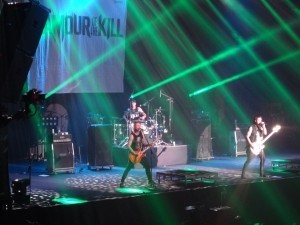
For the time being I stayed on the ranks and wandered from left to right depending on which stage the bands played on. Next up was the Gazette, the only Japanese band of the line-up. A visual rock band with a quite “typical” Japanese sound. There was a fan-girl on the ranks in front of me who made quite a dance and I was surprised why she didn’t venture down into the arena, but maybe she wanted some space!
After the Gazette, I ventured to the other side of the arena again and for the second time sneaked my way into the actually reserved seats area to get a good look at Belphegor, a deeply deeply black metal act from Austria. Their looks and props were quite fascinating and I took a lot of pics of them, especially of the drummer. He must have had color contact lenses in his eyes, which, with the distance to the stage and the lightning made his eyes shine like live from the land of the dead (pun intended). Their sound is way too dark for my taste but they looked pretty awesome and how the singer said “loudpark” in growling mode was a blast too.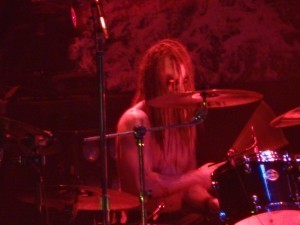
The contrast could not have been sharper and from the depths of blackest metal we had rock’n roll next with another UK band called Thunder. I admit to have never heard of these guys before and I am also still wondering what they were doing at Loudpark. Grandpas in checkered shirts playing soft hard-rock (pun intended). Nice, but way too nice for my taste.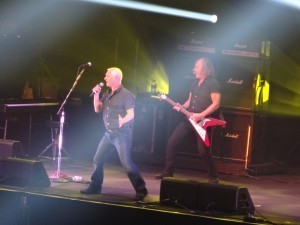
To wedge Thunder between Belphegor and The Haunted was interesting too. The Haunted from Sweden somehow sounded American to me, I don’t know why. The singer was very moved by the as always incredibly supporting Japanese audience. His make-up looking like he had a bullet wound in the head looked pretty cool.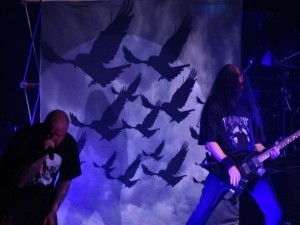
Then another very old and traditional band was up – Riot from the US. Man, they started out in the seventies… I looked at their history in Wikipedia and they’ve had a hell of a lot of band member deaths and the current vocalist is their 5th. Therefore Riot V. The singer did a good job at falsetto but all in all their music style was “too old” to thrill me.
After Riot I went down to the arena finally to get a good spot for Within Temptation and found one at the edge of the “big rock stage” balustrades which provided also a good look across to the “ultimate stage” where a US band called Death Angel played. Thrash metal, nice, good thrash metal. Next to Glamour of the Kill, Death Angel is my second favorite discovery of this Loudpark day. Their singer (awesome head of hair, man!) was also very moved by the Japanese audience. It was their first time at Loudpark (and thus in front of a bigger audience here) and they seemed really happy to be there. Cool band, I shall explore them a bit more.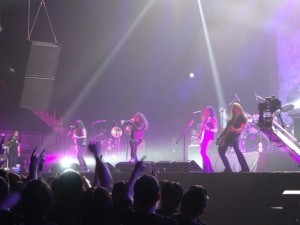
Within Temptation did two ballads, which were probably too slow for Loudpark and I found the lady’s comment to whatever song – “we wrote this ten years ago and the world hasn’t become better”… eh? Of course it hasn’t. – rather inappropriate and off the point. I also found it very weird that their poor drummer was sitting behind a Plexiglas/plastic screen – is he too loud or what?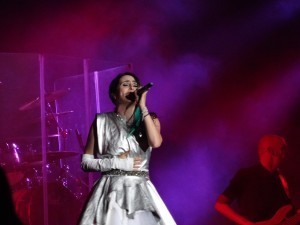
I much preferred one comment from Kreator – fxxk religion and even more so fxxk politics! I stayed in my spot in the arena for half of Kreator – nice slash metal from guys who know their stuff. After half of Kreator I left the arena to be able to leave when I wanted to instead of being squeezed in by Dream Theater fans.
For Dream Theater I returned to the ranks and took it easy and I must admit I left before they were done, in order to escape the crowds squeezing into the train and also because I am not exactly a Dream Theater fan. They “fiddle” too much in my opinion and don’t come to the point (of the song).
So, two new bands discovered – Death Angel and Glamour of the Kill. Good result for a good Loudpark 14. Let’s see what the line-up will be next year 
The full set of pics you can find on Flickr.
October 18, 2014
Soon to Come – Give Substance to a Thought
My latest novel, “Give Substance to a Thought” will soon see the light of day (November, if all goes well).
It’s the last part of my Hagen Patterson trilogy. Thus it is also the first time that I finished a trilogy in novel form. The entire trilogy took roughly 260,000 words to tell (80,000 + 85,000 + 95,000), not bad considering that the first volume “She Should Have Called Him Siegfried” originally was supposed to be a stand-alone.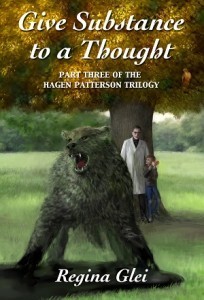
Funnily, the second part was easiest to write. The first draft of “To Mix and To Stir” took me barely 5 weeks. The first draft of the last part – “Give Substance to a Thought” took about 4 months to write.
I kept the same structure throughout the entire trilogy = Alchemist Hagen Patterson as the main POV in third person limited. Then in each book another minor 3rd person limited POV – In part 1 Hagen’s mother Emma, in part 2 Hagen’s alchemy “candidate” (precursor to apprentice) Lana Hardwood and in part 3 the minor 3rd person limited POV has fallen to the alchemists’ arch enemy – the head of the “governmental agents” – a guy called Andy Mitchell. Further each book has a more or less mysterious 1st person POV who tells her story in present tense. In part one that was Hagen’s potion client Helena, in part two a strange lady who turns out to be Al’s wife and in part three it is an even more mysterious entity from Al’s realm that I shall make a secret of right now.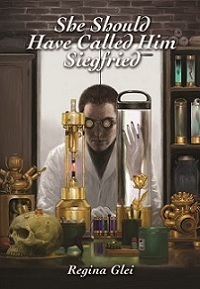
Last but not least there are “reports” from the governmental agents. Most of them are to be found in part 1, in part 2 they are still there, but in reduced form. Now, since in part 3 one of the agents is a POV character I decided to not use these reports anymore, except for one. In the prologue myself, the author, is agent no. 1 and gives a bit of a summary in the style of “what happened before”. I wrote several versions of this prologue, once in Hagen’s mother’s Emma’s POV even, but then decided to become agent 1 and do the summary in a “neutral” form. I was thinking for a long time whether to do this summary at all or not, but one of my beta-readers advised me to better leave it in, since the piece is so plot-heavy. Is it???  If the Hagen trilogy is plot heavy you haven’t read my second Dome of Souls novel yet. lol. Well, nobody has read that one yet, since the first draft was just finished some 2 weeks ago
If the Hagen trilogy is plot heavy you haven’t read my second Dome of Souls novel yet. lol. Well, nobody has read that one yet, since the first draft was just finished some 2 weeks ago  I would call that one plot-heavy indeed
I would call that one plot-heavy indeed 
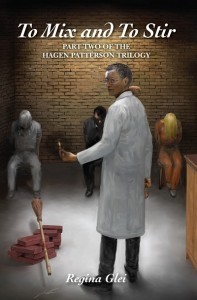
Back to Hagen and the rest of the cast.
At the end of To Mix and to Stir is the big revelation of who Al is. Part 3 now deals with the “real” Al and his realm and Hagen is quite torn between his “normal” life that consists of brewing potion, being a father of three children and dealing with the governmental agents on the one hand and Al and his problems on the other. Looking at the end of the book – man, it is quite long, since all those threads need to be brought to a closure (Yes, there will be closure, if with a loophole ;-))
Another thing about structure is the timing and pace of the trilogy. the “Siegfried” novel happened within a span one half a year, “To Mix and To Stir” within the span of a few weeks (I think it’s six, I must check again) 13 years after part 1, and “Give Substance” now takes places within the span of a few days (some two weeks in total) and picks up right where “To Mix and To Stir” left off. Such deliberate scheduling has its challenges but it also provides a nice frame that I could hold on to while writing it. And one more bit about structure: Book 1 started with Hagen’s POV, Book 2 started with the POV of the minor 3rd person limited character – in this case Lana Hardwood. Book 3 starts with the mysterious 1st person POV in present tense. It’s all deliberate…
I had great fun constructing this world and also Al’s realm and I hope you will like the grand finale of my musings about the problems of my favorite alchemist of all times – Hagen Patterson  – And I personally am very very happy with Katoh sensei’s magnificent covers for all three Hagen books! Thank you Katoh sensei!
– And I personally am very very happy with Katoh sensei’s magnificent covers for all three Hagen books! Thank you Katoh sensei!
October 11, 2014
To Boldly Go Where Many Have Gone Before
It’s time for a little car adventures update 
After hibernating between May and June and doing refresh lessons with my trusted driving teacher three times in July, I am since boldly riding the car about once a week. Curving around on Niijima island was a nice boost (see Niijima blog here) but driving on a relatively lonely island versus driving in Kawasaki/Yokohama/Tokyo is quite a different caliber. Nevertheless, I am boldly going where many people have gone before…
I am still hella nervous before getting into the car. Driving itself is actually not that bad, but the fear of parking diminishes the joy of driving… I went to Coscto again in between and once to Ikea and twice to a Japanese furniture shop in hunt of a new kitchen chair. Amazing, hu? Lol. Then I found a new favorite supermarket, a Fuji store that has an always rather empty parking area on its roof. There I practice parking backwards twice from the left and once from the right before I do some shopping. Small adventures will make us stronger! To all these places I can go without the navi demanding additional attention.
The plan for tomorrow is to head down the 246 again and to go to Costco before typhoon No. 19 hits us.
In general I think the traffic behavior in Japan is pretty damn civilized. People park in the most impossible spaces due to lack of space, but I’m rarely being cut off or things like that. I drive very carefully and very politely towards the people around me at the moment and let cars pass, allow them to filter in etc. and drivers thank me with hand-signs or the Japanese version of a thanks by flashing hazard lights for a bit. I rarely get honked at, well, sometimes, e.g. when I left my garage recently and cut off a guy on a scooter who shot past me from a dead angle. But then, don’t drive so fast in a residential area where any time anywhere people leave their garages…
So, all in all the urban jungle is still pretty scary and I have not yet managed to leave it behind me to go to the Hakone mountains for example. Highway… hm… I haven’t been alone on the highway yet either, I admit. When I look at the Tomei express way though, which I underpass every morning on the way to work, cars on it are always crawling, not driving… just too crowded!
Well, I shall take it slow and try to reduce the nervousness level by taking familiar paths until, after 5000 km??? I finally feel better… Including Niijima I am slowly approaching my first 1000 km, not quite there yet, but soon 
Guess I will have to drive to the dealer a couple of times now too, a) there has been a recall for the Suzuki Swift because of some dust collector somewhere and b) if I go there to have that part exchanged, they will notice the bump in the back which I made in my own garage and surely propose to get it fixed… In May, before the hibernating started, I don’t know what I did, but appear to have gone into neutral, rolled backwards in my sloping garage and hit a wooden storage casket in the back… nice bump! Sigh…
Such are the hustles of my “dramatic” car life 

